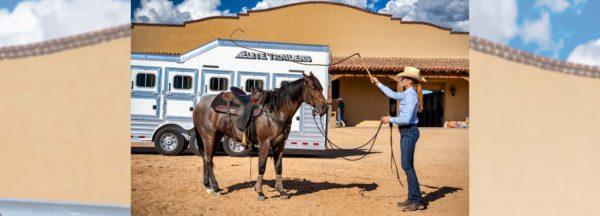Training Tip: Help for a Spooky Rope Horse

Question: I have a mare that’s scared of everything. I cow horse and rope on her. I can’t carry a horn wrap on her because she’ll try and run off. How do I desensitize her? – Preston Williams
Answer: It sounds like you may have some holes in your foundation and need to go back and do a better job with the Fundamentals exercises. When working on the exercises, remember to balance sensitizing exercises (asking the horse to move his feet) with desensitizing exercises (asking the horse to stand still and relax when approached with an object or stimulus).
If you do too much sensitizing, your horse will be responsive but will feel as if she’s on crack, spooking at everything around her. If you only desensitize your horse, she’ll be calm and relaxed, but will get an attitude when you ask her to move her feet. You have to work on both types of exercises equally to get a responsive, calm horse that uses the thinking side of her brain.
When you’re introducing a new object to your mare, such as a horn wrap, start in the least threatening manner possible. That would mean moving the object in the airspace near her. How close you can bring it to her will depend on her fear level. If she’s really frightened of it, you may have to move it 20 feet away from her. Treat desensitizing her to the horn wrap as you would desensitizing her to plastic bags.
Use the Approach and Retreat Method to desensitize her to it, gradually moving it closer to her and eventually touching her body with it. You’ll know she’s ready for you to increase the pressure (move the object closer to her) when she stands still and shows a sign of relaxing. When a horse relaxes, they’ll cock a hind leg, take a big breath, lick their lips, lower their head and neck, or blink their eyes. It may take you several days of consistent desensitizing until your mare is confident enough to accept the object touching her. That’s OK. Take the time that it takes to build her confidence.
During training sessions, keep the scary object nearby so that after you do a sensitizing exercise, you can immediately bring the object out and desensitize her to it. That way she will connect the object with getting to rest and get her air back.
Once your mare is comfortable with you using Approach and Retreat with the horn wrap, attach it to the saddle and do groundwork so she can get used to it without a rider on her back. We do this when desensitizing a horse to us cracking a stock whip while in the saddle. Before we can build the horse’s confidence about us cracking the whip, he has to be comfortable with seeing and feeling the whip move around him.
Some horses are just naturally more wary of their environment than other horses. I talk about this a lot in the Performance Horse Reined Cow Horse Series. I see a big difference in how sensitive the cow horses are to everything around them compared to reining horses. It makes sense, though. You want those cow horses to be alert and ready to read a cow and move with it. On the other hand, you want a reiner to be laidback and tuned in only to what you’re asking him to do in the moment.
Even though your mare may be more on the sensitive side of the scale and have a tendency to be reactive and spook, it doesn’t mean that when something startles her or she’s introduced to a new object that it needs to be a big deal. By teaching her the Fundamentals desensitizing exercises and consistently desensitizing her throughout your training sessions, you’re showing her how she should react and reinforcing the importance of using the thinking side of her brain and trusting you as her leader.
The more you practice desensitizing her, the faster she’ll become about relaxing and using the thinking side of her brain when something does startle her. I tell people to think of the thinking side of a horse’s brain like a muscle. The more you use it, the stronger it gets.
Looking for more training tips? Check out the No Worries Club. Have a training question? Send it to us at [email protected]
